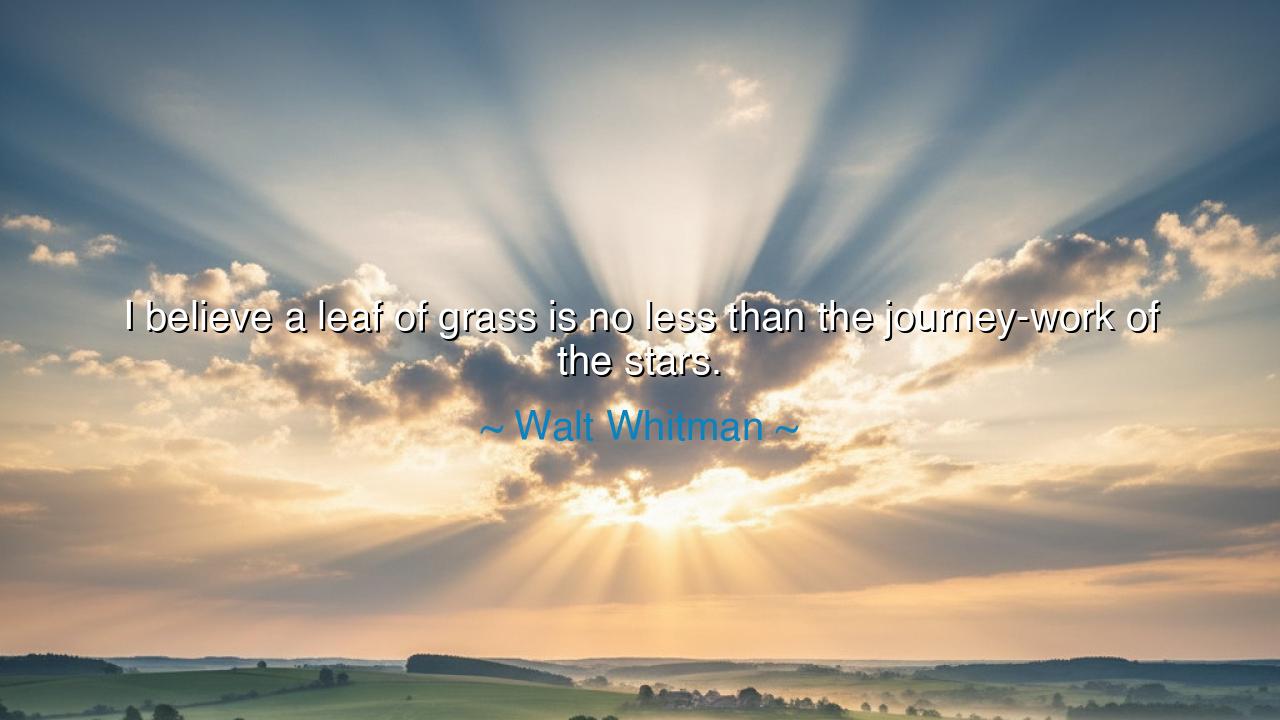
I believe a leaf of grass is no less than the journey-work of






Walt Whitman, the poet of democracy and the celebrant of the ordinary, once proclaimed: “I believe a leaf of grass is no less than the journey-work of the stars.” In this declaration, he unveiled a truth both cosmic and intimate: that the smallest fragment of nature, a blade of grass beneath our feet, is bound by the same laws and glory as the vast heavens above. In these words, he collapses the distance between the humble and the magnificent, teaching us that the infinite resides not only in galaxies and suns, but also in the common green that grows unnoticed in the fields.
The origin of this thought is found in Whitman’s Leaves of Grass, his great work and lifelong testament to the sacredness of all life. Living in the nineteenth century, when science was expanding human understanding of the cosmos, Whitman embraced the revelations of astronomy, geology, and evolution, yet refused to separate science from reverence. To him, the stars and the grass shared a kinship, each born of the same eternal processes. The stars burned in heaven, but their light touched the grass; the grass grew from the soil, but its atoms had once been part of stars. He understood, intuitively, what modern science has proven: that we are all stardust, that the universe lives within even the smallest leaf.
The ancients, too, sensed this harmony. The Stoics believed in the logos, a divine reason pervading all things, from the constellations to the pebbles on the ground. The poets of India sang that “what is above is like what is below.” To them, the universe was one great body, every part reflecting the whole. Whitman, like these sages, saw in the leaf of grass not mere vegetation, but a revelation of cosmic order. He gave voice to an ancient intuition: that to step upon the earth carelessly is to tread upon the handiwork of eternity.
History shows us examples of those who rediscovered this truth in times of wonder or despair. Consider Charles Darwin, journeying through the Galápagos, who marveled that the tiniest finch or the simplest plant carried within it the grand story of life’s evolution. Or think of astronauts gazing back upon Earth from space—men who had reached the realm of the stars, only to be struck by the fragile beauty of the green planet below. One of them said, “The Earth is what we all have in common.” In their awe, they echoed Whitman: the greatness of the stars is mirrored in the smallest living thing.
The meaning of Whitman’s words is deeply motivational. They remind us to cast off arrogance and awaken to reverence. We often glorify the distant and the unattainable while dismissing the near and familiar. Yet the grass beneath our feet is as wondrous as the farthest galaxy, for both are woven of the same substance, animated by the same mystery. To see this is to live with humility and gratitude, to honor all forms of life, no matter how common they appear.
The lesson is clear: cultivate wonder not only for the heavens but for the earth. Do not pass by the ordinary without reverence. A single leaf of grass contains the story of creation, as surely as the light of the stars. When you walk in fields or gardens, pause and look closely. Let the simplicity of the grass teach you the grandeur of existence. In honoring the smallest, you honor the whole; in seeing the eternal in the common, you train your heart to wisdom.
Thus Whitman’s words endure as both hymn and commandment: “I believe a leaf of grass is no less than the journey-work of the stars.” They summon us to see the cosmos in the ordinary, to find the infinite in the finite, to live with reverence for both the heavens and the earth. For the same hand that cast the stars in their courses has shaped the leaf, and in both, if we open our eyes, we may behold eternity.






AAdministratorAdministrator
Welcome, honored guests. Please leave a comment, we will respond soon